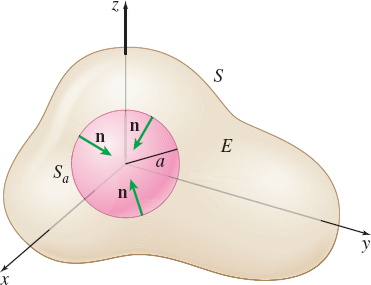EXAMPLE 5Applying the Divergence Theorem to an Electric Force Field
Let F=F(x,y,z) be an electric force field F=F(x,y,z)=εqQx2+y2+z2u
where ε is a constant that depends on the units used; q and Q are the charges of two objects, one located at the point (0,0,0) and the other at a point (x,y,z); and u is the unit vector in the direction from (0,0,0) to (x,y,z). Let S be a closed surface with positive orientation that encloses a solid E in space.
Show that the following statements are true under the assumptions of the Divergence Theorem:
- (a) If neither S nor its interior contains the point (0,0,0), then ∬. That is, the flux of \mathbf{F} across S equals 0.
- (b) If the interior of S contains the point (0,0,0), then \iint\limits_S \mathbf{F}\,{\bf\cdot}\, \mathbf{n}\,dS=4\pi \varepsilon qQ. That is, the flux of \mathbf{F} across S equals 4\pi \varepsilon qQ.
Solution The unit vector \mathbf{u}=\dfrac{x\mathbf{i}+y\mathbf{j }+z\mathbf{k}}{\sqrt{x^{2}+y^{2}+z^{2}}}, so that \mathbf{F}=\mathbf{F}(x,y,z)=\varepsilon qQ\dfrac{x\mathbf{i}+y\mathbf{j}+z \mathbf{k}}{(x^{2}+y^{2}+z^{2})^{3/2}}
The electric force field \mathbf{F} is continuous everywhere except at the point (0,0,0).
(a) The surface S that forms the boundary of the solid E satisfies the assumptions of the Divergence Theorem. We find {\rm{div}} \mathbf{F}. \begin{eqnarray*} {\rm{div}}\mathbf{F}&= &\varepsilon qQ\left\{\dfrac{\partial }{\partial x}\left[ \dfrac{x}{ (x^{2}+y^{2}+z^{2})^{3/2}}\right] +\dfrac{\partial }{\partial y}\left[ \dfrac{y }{(x^{2}+y^{2}+z^{2})^{3/2}}\right] +\dfrac{\partial }{\partial z}\left[ \dfrac{z}{(x^{2}+y^{2}+z^{2})^{3/2}}\right] \right\} \\ &=&\varepsilon qQ\bigg\{\dfrac{(x^{2}+y^{2}+z^{2})^{3/2}-3x^{2} \sqrt{x^{2}+y^{2}+z^{2}}}{(x^{2}+y^{2}+z^{2})^{3}}+\dfrac{ (x^{2}+y^{2}+z^{2})^{3/2}-3y^{2}\sqrt{x^{2}+y^{2}+z^{2}}}{ (x^{2}+y^{2}+z^{2})^{3}} \\ &&+\,\dfrac{(x^{2}+y^{2}+z^{2})^{3/2}-3z^{2}\sqrt{x^{2}+y^{2}+z^{2}}}{ (x^{2}+y^{2}+z^{2})^{3}} \bigg\} \\ &=&\varepsilon qQ\dfrac{3(x^{2}+y^{2}+z^{2})^{3/2}-3\sqrt{x^{2}+y^{2}+z^{2}}(x^{2}+y^{2}+z^{2})}{(x^{2}+y^{2}+z^{2})^{3}}=0 \end{eqnarray*}
Therefore, by the Divergence Theorem, \iint\limits_{S}\mathbf{F}\,{\cdot}\, \mathbf{n}\,dS=\iiint\limits_E {\rm{div}} \mathbf{F}\,dV=0
(b) Since the interior of S contains the origin, \mathbf{F} is not continuous at the origin, so we cannot use the Divergence Theorem. We use the following argument to prove (b). Let E be the closed solid enclosed by two separate surfaces: the surface S and a sphere S_{a} of radius a, with its center at (0,0,0), as shown in Figure 70. The outer surface is S and the inner surface is S_{a}. Now \mathbf{F} is continuous throughout E, so the Divergence Theorem can be used. \iiint\limits_E {\rm{div}}\mathbf{F}\,dV=\iint\limits_{S}\mathbf{F}\,{\cdot}\, \mathbf{n}\,dS+\iint\limits_{S_{a}}\mathbf{F}\,{\bf\cdot}\, \mathbf{n}\,dS
1044
From (a), we know that \iiint\limits_{E}{\rm{div}}\mathbf{F}\,dV=0. So, \iint\limits_{S}\mathbf{F}\,{\bf\cdot}\, \mathbf{n}\,dS=-\iint\limits_{S_{a}}\mathbf{F }\,{\bf\cdot}\, \mathbf{n}\,dS
On the inner surface S_{a}, a sphere of radius a, the outer unit normal is \mathbf{n}=-\dfrac{x\mathbf{i}+y\mathbf{j}+z\mathbf{k}}{a}=-\dfrac{x\mathbf{i}+ y\mathbf{j}+z\mathbf{k}}{\sqrt{x^{2}+y^{2}+z^{2}}}
Then \begin{eqnarray*} \mathbf{F}\,{\bf\cdot}\, \mathbf{n\,} &=&\dfrac{\varepsilon qQ}{x^{2}+y^{2}+z^{2}} \mathbf{u}\,{\bf\cdot}\, \left( -\dfrac{x\mathbf{i}+y\mathbf{j}+z\mathbf{k}}{\sqrt{ x^{2}+y^{2}+z^{2}}}\right)\\ &=&-\dfrac{\varepsilon qQ}{x^{2}+y^{2}+z^{2}}\dfrac{x \mathbf{i}+y\mathbf{j}+z\mathbf{k}}{\sqrt{x^{2}+y^{2}+z^{2}}}\,{\bf\cdot}\, \dfrac{x \mathbf{i}+y\mathbf{j}+z\mathbf{k}}{\sqrt{x^{2}+y^{2}+z^{2}}} \\ &=&-\varepsilon qQ\dfrac{x^{2}+y^{2}+z^{2}}{a^{4}}=-\dfrac{\varepsilon qQ}{ a^{2}} \end{eqnarray*}
So,
